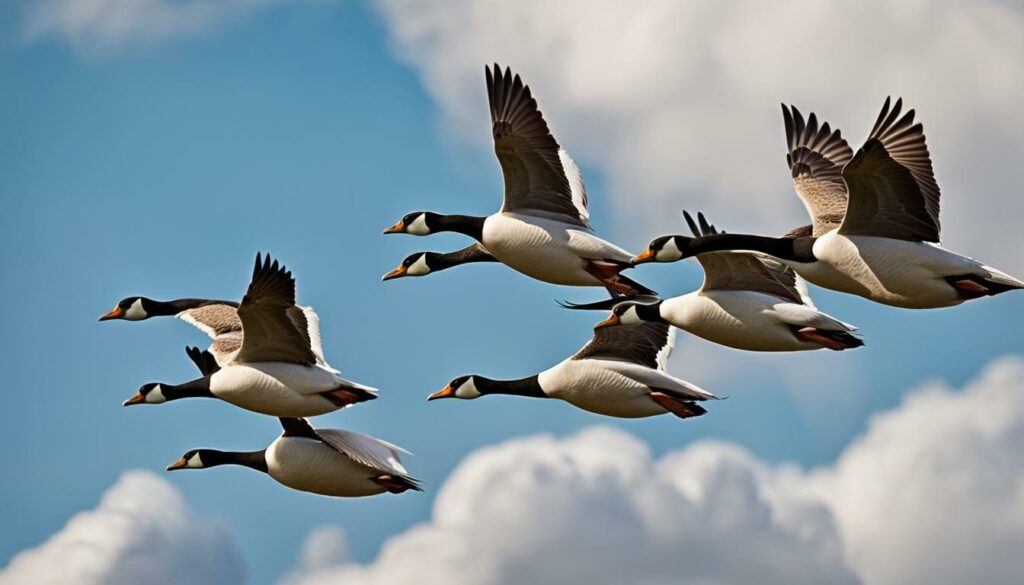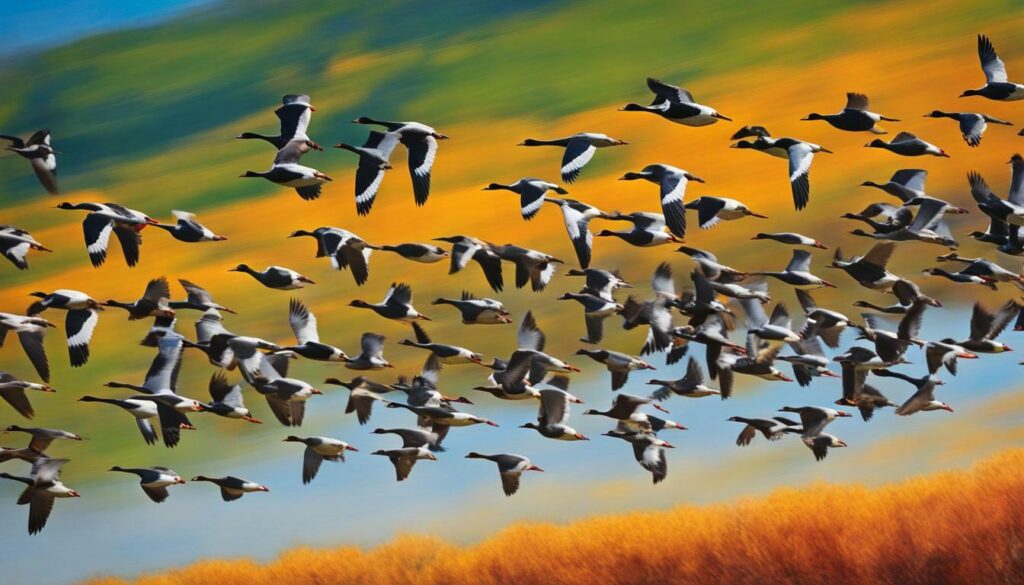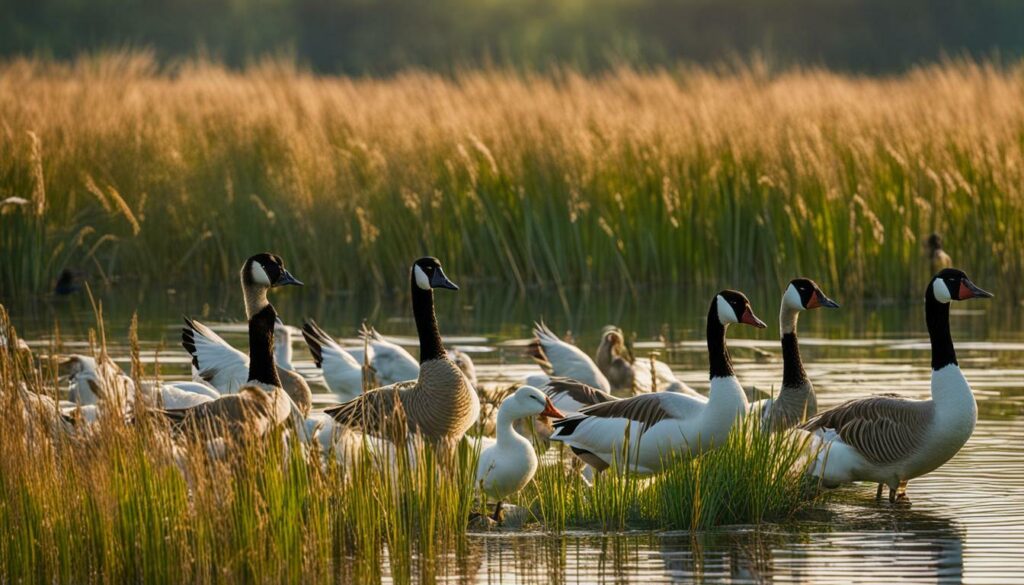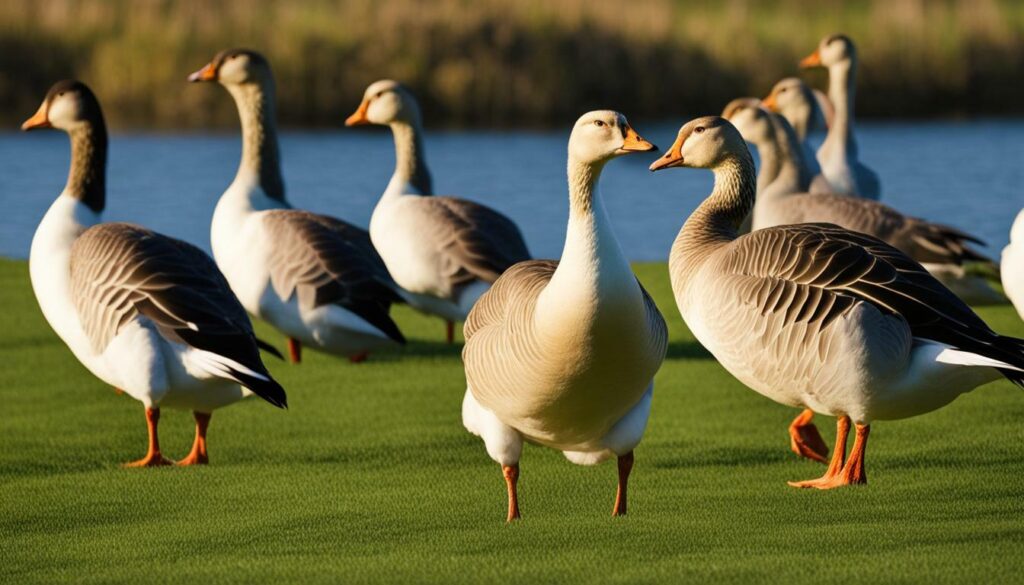Welcome to the fascinating world of geese, where we’ll dive into their incredible abilities and learn some remarkable insights about these captivating birds. Geese are social creatures that form strong pair bonds and mate for life. They are known for their exceptional flight abilities, herbivorous diet, and adaptations for life in and around water. With a complex communication system and protective parenting instincts, geese are truly remarkable animals. They also play important ecological roles, have impressive sensory abilities, and are quick learners. In this article, we’ll explore the many facets of geese and discover why they hold such cultural significance. So, let’s begin our journey into the fascinating world of geese!
- Geese form strong pair bonds and mate for life.
- They are exceptional fliers and have impressive flight abilities.
- Geese primarily have a herbivorous diet and are adapted to life in and around water.
- They have a complex communication system using honks and body language.
- Geese are protective parents and fiercely defend their nests and young.
Geese: Social Birds with Strong Pair Bonds
Geese are incredibly social birds that form strong pair bonds, creating lifelong partnerships that are the foundation of their social structure. These bonds are so important that if one partner dies, the surviving goose may choose to remain single for the rest of its life. They are known for their loyalty and commitment, and they actively seek out a mate each breeding season.
These social birds engage in various displays of affection towards their partners, such as vocalizations and nonverbal communication. They are often seen preening each other’s feathers, a behavior known as allopreening, which strengthens their bond and maintains their plumage in top condition. It’s a heartwarming sight to witness these interactions between geese, as they reaffirm their pair bonds and strengthen their social connections.
| Fun Fact | Quote |
|---|---|
| Geese mate for life | “A goose is a friend that sticks with you for life, through thick and thin.” – Anonymous |
| Geese are loyal and devoted to their partners | “Love is like a pair of geese, always together and never apart.” – Unknown |
| Geese actively seek out a mate each breeding season | “A goose knows that love is worth the migration.” – Author Unknown |
These strong pair bonds extend beyond the breeding season. Geese often migrate in large flocks, and during their journey, they maintain their partnerships and stay close to their mates. Their synchronized flight in V formation is not only energy-efficient but also allows them to maintain visual contact with each other, reinforcing their bonds even during long migrations.
So, the next time you spot a pair of geese gracefully gliding across the sky or paddling together in a serene pond, take a moment to appreciate their strong social bonds and the lifelong partnerships that make these majestic birds truly remarkable.

Geese are incredibly social birds that form strong pair bonds, creating lifelong partnerships that are the foundation of their social structure. These bonds are so important that if one partner dies, the surviving goose may choose to remain single for the rest of its life. They are known for their loyalty and commitment, and they actively seek out a mate each breeding season.
These social birds engage in various displays of affection towards their partners, such as vocalizations and nonverbal communication. They are often seen preening each other’s feathers, a behavior known as allopreening, which strengthens their bond and maintains their plumage in top condition. It’s a heartwarming sight to witness these interactions between geese, as they reaffirm their pair bonds and strengthen their social connections.
“A goose is a friend that sticks with you for life, through thick and thin.” – Anonymous
These strong pair bonds extend beyond the breeding season. Geese often migrate in large flocks, and during their journey, they maintain their partnerships and stay close to their mates. Their synchronized flight in V formation is not only energy-efficient but also allows them to maintain visual contact with each other, reinforcing their bonds even during long migrations.
So, the next time you spot a pair of geese gracefully gliding across the sky or paddling together in a serene pond, take a moment to appreciate their strong social bonds and the lifelong partnerships that make these majestic birds truly remarkable.
The Flying Wonders: Geese’s Impressive Flight Abilities
Geese are not only impressive in their social dynamics but also in their flight abilities, as these birds are exceptional fliers known for their long-distance journeys. Their specialized wings and body structure allow them to navigate through the air with ease, reaching impressive speeds and covering vast distances.
One of the most remarkable flight abilities of geese is their ability to fly in a V formation. This formation is not just for aesthetics but serves a practical purpose. By flying in a V, geese create an aerodynamic advantage where the undercurrent from the bird in front creates lift for the bird behind, reducing wind resistance and conserving energy. This energy-saving technique allows geese to fly for long periods without tiring.
Geese are also known for their migratory patterns, traveling thousands of miles in search of suitable habitats and food sources. They have the remarkable ability to navigate using landmarks, celestial cues, and even the Earth’s magnetic field. It’s truly fascinating how these birds can embark on such long and perilous journeys, relying solely on their innate instincts.
| Geese’s Flight Abilities | Description |
|---|---|
| Long-Distance Travelers | Geese undertake impressive migrations, covering thousands of miles in search of favorable conditions. |
| Aerodynamic V Formation | By flying in a V-shaped formation, geese reduce wind resistance and conserve energy during long flights. |
| Navigation Skills | Geese rely on landmarks, celestial cues, and the Earth’s magnetic field to navigate their migration routes. |
Geese’s flight abilities are not only functional but also awe-inspiring. Their graceful and synchronized movements in the sky are a sight to behold. So the next time you spot a flock of geese flying overhead, take a moment to appreciate the marvel of their flight abilities and the extraordinary journeys they undertake.

“The flight of geese is not only a beautiful spectacle but also a reminder of the power of teamwork and collaboration.” – Unknown
- Geese are exceptional fliers, known for their long-distance journeys.
- They fly in a V formation for energy efficiency.
- Geese rely on navigation skills to migrate.
Geese’s Herbivorous Diet and Water Adaptations
Geese have a herbivorous diet, mainly consisting of plants, and their bodies are well-adapted for their lifestyle near water. These feathered grazers have a knack for finding and devouring a variety of vegetation, including grasses, sedges, and aquatic plants. Their strong bills are perfectly designed for tearing and consuming plant matter, allowing them to efficiently extract nutrients from their chosen food sources.
But it’s not just their diet that showcases their adaptation to water. Geese also possess specialized physical features that enable them to thrive in aquatic environments. For instance, their webbed feet are ideal for paddling through water, while their oily feathers provide excellent insulation and buoyancy. This combination of features allows geese to effortlessly glide across ponds, lakes, and wetlands, whether during regular foraging or when seeking refuge from potential threats.
| Geese’s Herbivorous Diet | Water Adaptations |
|---|---|
|
|
Geese’s herbivorous diet not only sustains their own bodies but also plays a vital role in the ecosystem. As they feed on plants, they help control the growth of vegetation, preventing overgrowth and maintaining the balance of their habitats. Additionally, their presence in wetland areas contributes to the overall health of these fragile ecosystems. Their constant interaction with water and consumption of plant matter ensures the preservation of wetlands, which serve as crucial habitats for a wide array of species.
So, the next time you come across a gaggle of geese near a body of water, take a moment to appreciate their unique diet and remarkable adaptations. These feathered grazers are not only a delight to observe but also a significant contributor to the delicate balance of their natural environment.
Did You Know?
Geese can consume up to four pounds of plant material in a day, thanks to their efficient digestive system. Their diet provides them with the necessary energy to support their remarkable flight abilities and their commitment to migration. So, every bite they take plays a crucial role in fueling their incredible journeys across vast distances.

Geese have a sophisticated communication system that involves honks and body language, allowing them to convey messages and establish their social order. These vocalizations and physical cues play a vital role in their interactions and group dynamics.
The language of honks is a crucial aspect of goose communication. They use different types of honks to convey various messages. For example, a loud and vigorous honk often signifies aggression or a warning to potential threats. On the other hand, a softer honk can indicate a call for attention or a sign of contentment. Geese honk to communicate with other members of their flock, maintaining contact and ensuring cohesion.
Aside from honks, geese also rely on body language to communicate their intentions and emotions. They use a range of physical cues, such as head movements, wing gestures, and posture, to convey their messages. For instance, a raised head and extended neck can be a sign of alertness or aggression, while a lowered head and relaxed posture may indicate a peaceful and contented state.
| Vocalizations | Meaning |
|---|---|
| Loud, vigorous honk | Aggression or warning |
| Soft honk | Call for attention or contentment |
Geese’s ability to understand and respond to each other’s honks and body language is essential for maintaining social harmony within their flock. It helps them coordinate activities such as foraging, mating, and navigation during their seasonal migrations. Through these intricate communication methods, geese establish and reinforce their social order, ensuring a cohesive and cooperative group dynamic.
Quotes:
“The language of honks and body language among geese is a fascinating aspect of their social behavior. It’s incredible how they can convey messages and establish their social order simply through vocalizations and physical cues.” – Dr. Jane Wilson, Avian Behavior Expert

- Geese have a sophisticated communication system involving honks and body language.
- Honks serve different purposes, from aggression warnings to calls for attention.
- Physical cues like head movements and posture also play a role in communication.
- Understanding and responding to each other’s signals helps maintain social harmony within the flock.
The language of honks and body language is just one fascinating aspect of geese’s communication abilities. It reflects their social intelligence and their capacity to navigate their intricate social dynamics. By honking and using various physical cues, geese can convey messages, establish their social order, and ensure the cohesion of their flock.
Protective Parenting: Geese’s Fierce Defense of Nests and Young
Geese are known for their fierce protectiveness when it comes to their nests and young, displaying a remarkable commitment to safeguarding their offspring. These devoted parents go to great lengths to ensure the safety and well-being of their goslings, even if it means putting themselves in harm’s way.
When it comes to defending their nests, geese are not to be underestimated. They will aggressively fend off any potential threats, hissing and honking loudly to intimidate intruders. Their large size and strong wings add to their formidable presence, making it clear that they mean business.
But their protective instincts don’t end there. Geese also go to great lengths to protect their young once they hatch. They keep a watchful eye on their goslings, herding them close and guiding them with gentle nudges. When danger approaches, the parents will form a defensive line, positioning themselves between their young and any potential threats.
Geese’s fierce defense of their nests and young is truly a sight to behold. It serves as a reminder of the incredible bond they share with their offspring and the lengths they will go to ensure their survival. It is a testament to the remarkable commitment and dedication displayed by these remarkable birds.

| Protective Behaviors of Geese | Description |
|---|---|
| Aggressive hissing and honking | Geese use vocalization to intimidate and ward off potential threats. |
| Defensive line formation | When danger approaches, geese position themselves between their young and the threat, forming a protective barrier. |
| Gentle nudging and guidance | Geese use physical cues to guide and protect their goslings, keeping them close and ensuring their safety. |
Geese’s Long Lifespan and Molt Migration
Geese have an impressive lifespan and undergo a fascinating molt migration process, shedding and regrowing their feathers. These remarkable birds can live up to 25 years in the wild, making them one of the longest-living bird species. Their longevity is due to their exceptional adaptability and natural defenses against predators, ensuring their survival throughout the years.
During the molt migration, geese shed and replace their flight feathers, allowing them to maintain optimal flight capabilities. This molt usually occurs in the summer months when geese have fewer demanding environmental factors to contend with. As they molt, geese become temporarily flightless, relying on their strong pair bonds and social groups for protection and support.
Throughout their molt migration, geese may gather in large flocks in specific locations, taking advantage of abundant food sources and safe resting areas. These communal gatherings offer geese the opportunity to socialize, form new pair bonds, and reinforce existing relationships. It’s truly a breathtaking sight to witness these majestic birds as they regroup and prepare for their upcoming migration.
Geese’s Molt Migration Table
| Migration Stage | Description |
|---|---|
| Feather Shedding | Geese begin to shed their old feathers, making way for new ones to grow. This process typically takes place over several weeks. |
| Flightless Period | During the molting phase, geese become temporarily flightless, relying on communal protection and support to navigate their surroundings. |
| Feather Regrowth | New feathers start to grow, gradually replacing the old ones. This phase is critical for geese to regain their ability to fly and maintain optimal flight performance. |
| Migration Preparation | As their feathers regrow, geese prepare for their long-distance migration by gathering in large flocks and replenishing their energy reserves. |
Geese’s molt migration is a testament to their incredible adaptability and resilience. It allows them to thrive in various habitats and continue their life cycle effectively. From shedding their old feathers to regrowing new ones, geese’s molt migration showcases their remarkable ability to navigate the ever-changing natural world.

As geese embark on their molt migration journey, they form the iconic V formation during flight, efficiently conserving energy and optimizing their flight range. This synchronized flight pattern minimizes air resistance and helps geese take turns leading the flock, distributing the physical strain evenly among the group.
Witnessing the magnificent sight of geese in a V formation during their molt migration is a testament to their strength, unity, and remarkable instinct. It’s a reminder of the wonders of nature and the resilience of these beautiful creatures.
Geese’s Cultural Significance and Association with Migration
Geese hold cultural significance and are often associated with migration in various artistic and literary representations. These graceful birds have captured the imaginations of people throughout history, symbolizing the beauty of nature and the wonders of the natural world. In folklore and mythology, geese are often depicted as messengers or guides, leading lost souls to their final resting place. Their annual migratory journey, spanning thousands of miles, has been a source of inspiration for poets, painters, and storytellers.

One famous example is the ancient Roman poem “The Song of the Geese,” which praises the birds for their loyalty, perseverance, and keen sense of direction. In this epic poem, the geese are hailed as noble companions on the journey of life, navigating the vastness of the sky with unwavering determination.
The association between geese and migration extends beyond artistic interpretations. Scientists have long marveled at the remarkable navigation skills of these birds. Geese utilize a variety of cues, such as the position of the sun, the Earth’s magnetic field, and visual landmarks, to navigate their way across vast distances. Their ability to follow age-old migration routes with pinpoint accuracy has fascinated researchers and shed light on the mysteries of avian navigation.
Table: Famous Artistic Representations of Geese and Migration
| Artwork | Artist | Year |
|---|---|---|
| “The Flight of the Geese” | John James Audubon | 1829 |
| “Geese in the Autumn Sky” | Matsuo Basho | 1692 |
| “Migration: A Symphonic Poem” | Richard Strauss | 1899 |
As we continue to appreciate the cultural significance of geese and their association with migration, let us be reminded of the enduring connection between humans and the natural world. Just as geese navigate through life’s challenges with determination and grace, may we find inspiration in their journey and strive to preserve the delicate balance of our planet’s ecosystems.
The Ecological Role of Geese: Weed Control and Wetland Health
Geese play a crucial ecological role, acting as natural weed controllers and serving as indicators of wetland health. These graceful birds may not seem like superheroes, but their presence in wetland habitats has a significant impact on the ecosystem.
One of the ways geese contribute to the environment is through their appetite for weeds. As herbivores, they have an affinity for munching on a variety of plant species that can become invasive and detrimental to wetlands. By feeding on these plants, geese help to keep their growth in check, ensuring a healthier balance in the ecosystem.
Additionally, geese can indicate the overall health of wetland habitats. Their presence in an area is often a sign of a thriving ecosystem, as they require clean water, abundant food sources, and suitable nesting sites. Conversely, a decline in the goose population could be an indicator of declining wetland health, pointing to potential issues such as pollution or habitat degradation.
| Diet | Water Adaptations |
|---|---|
| Geese primarily feed on plants such as grasses, sedges, and aquatic vegetation. | They have adaptations such as webbed feet and oil glands that help them navigate and stay buoyant in water. |
“Geese are like nature’s weed trimmers, keeping the balance in wetland ecosystems by feasting on invasive plants.”
By fulfilling their ecological role, geese contribute to the overall health and sustainability of wetland environments. Their weed control efforts help maintain diverse plant communities, which in turn provide habitat and food sources for other species. Understanding and appreciating the ecological significance of geese can deepen our understanding of the delicate balance within ecosystems and the importance of preserving wetland habitats.

So, the next time you spot a flock of geese gracefully gliding across a wetland, take a moment to acknowledge their important role as weed controllers and guardians of wetland health. These majestic birds are not only a delight to observe but also essential players in maintaining the harmony of our precious wetland ecosystems.
Geese’s Impressive Visual Capabilities and Nocturnal Adaptations
Geese have remarkable visual capabilities, including the ability to see in UV light, and possess adaptations that aid them in navigating at night. Their keen eyesight allows them to spot potential predators and obstacles even in low-light conditions. This impressive visual acuity is especially useful during their nocturnal travels.
One of the adaptations that enable geese to navigate at night is their large eyes, which allow for a wider field of vision. This helps them to detect any changes in their surroundings, ensuring they can avoid danger and stay on course. Additionally, their eyes are highly sensitive to movement, allowing them to quickly spot any potential threats or prey.
Another fascinating aspect of geese’s visual capabilities is their ability to see in UV light. This means they can perceive a range of colors that humans cannot. This unique ability may assist them in identifying food sources, finding mates, and recognizing other geese. It provides them with an extra level of visual information that enhances their ability to navigate and interact with their environment.
Geese’s impressive visual capabilities and nocturnal adaptations allow them to thrive in various habitats, including dimly lit areas and during nighttime migrations.
While geese primarily rely on their visual senses, they also possess other sensory adaptations that aid them in nocturnal navigation. For example, they have well-developed hearing, allowing them to detect subtle sounds that may indicate danger or the presence of other geese. Additionally, their excellent sense of touch, particularly in their bills, helps them to locate food in the darkness and explore their environment with precision.
Overall, geese’s visual capabilities and nocturnal adaptations highlight their incredible ability to adapt and thrive in different environments. From their exceptional eyesight, including the ability to see in UV light, to their heightened senses of hearing and touch, these adaptations ensure their success as they traverse the world, even after the sun sets.
| Visual Capabilities | Nocturnal Adaptations |
|---|---|
| Ability to see in UV light | Large eyes for wider field of vision |
| Enhanced visual acuity | High sensitivity to movement |
| Well-developed hearing to detect sounds | |
| Excellent sense of touch, particularly in their bills |
Geese’s Impressive Visual Capabilities
- Ability to see in UV light, perceiving a wider range of colors
- Keen eyesight for spotting predators and obstacles
- Large eyes for a wider field of vision
- High sensitivity to movement
Nocturnal Adaptations
- Well-developed hearing to detect sounds in the darkness
- Excellent sense of touch, particularly in their bills
- Ability to navigate and thrive in dimly lit areas

Geese’s Sensory Abilities: Sleeping with One Eye Open and Sensitive Bills
Geese have fascinating sensory abilities, such as the ability to sleep with one eye open and their bills being equipped with touch receptors. These unique features allow them to stay alert to potential dangers even while resting. Imagine being able to catch some Z’s while remaining vigilant – talk about a handy survival skill!
Not only can geese sleep with one eye open, but their bills also play a crucial role in their day-to-day activities. Equipped with touch receptors, their bills serve as versatile tools for navigating their environment, finding food, and communicating with other geese. It’s like having a built-in sensory superpower.
“Geese’s ability to sleep with one eye open is truly remarkable. It allows them to rest while staying on high alert for any signs of danger. Their sensitive bills also serve as incredible tools, helping them navigate their surroundings and communicate with precision.”
With their exceptional sensory abilities, geese are in tune with their surroundings and can adapt swiftly to changes in their environment. They rely on their keen senses to detect predators, locate food, and communicate effectively within their flock. It’s no wonder they have thrived as a species for so long!
| Sensory Abilities | Adaptations |
|---|---|
| Sleeping with One Eye Open | Allows geese to rest while remaining alert to potential dangers. |
| Sensitive Bills | Equipped with touch receptors, geese rely on their bills for navigation, finding food, and communication. |
Geese as Quick Learners and Early Swimmers
Geese are quick learners, and it’s incredible to see how young goslings can imitate adults and take to the water just a day after they hatch. They have an innate instinct for swimming, which allows them to navigate their watery habitat with ease. It’s a remarkable sight to witness these adorable fluffy creatures paddling around confidently as if they’ve been doing it their entire lives.
Not only do geese learn to swim at an early age, but they also develop other skills rapidly. As they grow, goslings observe and mimic the behavior of adult geese, learning essential survival techniques and social interactions. This process of observational learning helps them adapt quickly to their surroundings and develop the necessary skills to thrive in their environment.
Geese’s ability to learn quickly and swim early is essential for their survival. Swimming allows them to access food sources that are inaccessible to land-based animals. Their aquatic diets primarily consist of vegetation such as grass, aquatic plants, and grains found in wetlands and water bodies. By being quick learners and early swimmers, geese can find nourishment and thrive in a variety of environments, including ponds, lakes, rivers, and even urban areas.
| Benefits of Quick Learning and Early Swimming for Geese |
|---|
| 1. Access to abundant food sources in wetlands and water bodies. |
| 2. Rapid adaptation to different environments. |
| 3. Enhanced survival skills through observational learning. |
| 4. Development of social interactions and communication skills. |
Geese’s ability to be quick learners and early swimmers sets them on a path towards a successful life. This remarkable skill ensures their survival and enables them to navigate their watery habitats with confidence. Through rapid adaptation and observational learning, geese develop the necessary skills for social interaction, foraging, and thriving in a diverse range of environments.

“Did you know that goslings have a natural buoyancy that makes them naturally buoyant in water? This buoyancy allows them to float effortlessly and learn to swim quickly.”
Whether they are gracefully gliding across a serene lake or playfully splashing in a puddle, geese’s ability to learn quickly and swim early is truly remarkable. It’s a testament to their intelligence and adaptability, showcasing the incredible world of geese and their fascinating abilities.
Geese’s Social Intelligence: Following the Gaze and Pre-communication
Geese possess remarkable social intelligence, being able to follow the gaze of others and even communicate with their parents while still in their eggs. This unique ability allows them to establish strong connections and maintain a sense of cohesion within the flock. It’s fascinating to observe how geese can read each other’s body language and understand subtle cues, leading to synchronized movements and efficient navigation.
When geese follow the gaze of their companions, it’s not just a simple act of looking in the same direction. It’s a form of communication that helps them stay connected and make collective decisions. By following the gaze of a leader, the rest of the flock can quickly detect potential threats or identify the best route during migration. This social intelligence ensures their survival and enhances their ability to navigate challenging environments.
Moreover, geese engage in pre-communication while still in their eggs. They use gentle vocalizations to let their parents know when they are ready to hatch. This pre-communication helps synchronize the hatching process, ensuring that the goslings emerge from their shells within a similar timeframe. It’s a testament to the intricate bond between geese parents and their unborn offspring, further highlighting their exceptional social intelligence.
| Social Intelligence of Geese | Examples |
|---|---|
| Following the Gaze | The ability to follow the gaze of others enables geese to make collective decisions and navigate as a united flock. |
| Pre-communication | Geese communicate with their parents while still in their eggs, synchronizing the hatching process and strengthening the bond within the family unit. |
Stories of Marvelous Geese Communication
“It’s awe-inspiring to witness the synchronized flight patterns of geese, where they effortlessly maintain perfect formation through following the gaze of the leader. It’s a testament to their exceptional social intelligence and ability to communicate in unison.”
Geese’s social intelligence is not only evident in their ability to follow the gaze and pre-communicate; it also extends to their remarkable coordination in flight. When geese migrate in their iconic V formation, they take advantage of the aerodynamic benefits it provides. By following the gaze of the lead goose, each bird behind can adjust its course and maintain optimal flight efficiency, reducing wind resistance and conserving energy. This remarkable display of synchronized flight and communication demonstrates the extraordinary social intelligence of geese.
Overall, geese’s social intelligence, characterized by following the gaze and pre-communication, showcases the remarkable bonds and cohesive nature of these fascinating birds. Whether it’s for survival during migration or ensuring the synchronized hatching of their offspring, geese’s ability to communicate within their flock is truly awe-inspiring.

Canada Geese: Largest Geese Subspecies and Story of Resilience
Canada geese, the largest subspecies of geese, have a fascinating story of resilience, from near extinction to their seasonal migrations and ability to thrive in urban environments.
Once on the brink of extinction in the early 1900s, Canada geese made a remarkable comeback thanks to conservation efforts. Today, these magnificent birds are well-known for their distinctive honks and their impressive V-shaped flight formations as they embark on their annual migrations.
One of the defining characteristics of Canada geese is their adaptability to urban environments. No longer solely limited to their natural habitat, these geese have successfully established populations in parks, golf courses, and even residential areas. They have become a familiar sight, gracefully navigating busy city parks and urban ponds.
However, Canada geese can be quite territorial and protective when it comes to their nests and goslings. They are known to fiercely defend their young, displaying unwavering dedication and courage. During the molting season, when they shed and regrow their feathers, Canada geese are particularly vulnerable to predators. This time of year can be challenging for them as they navigate the dangers of their environment.
Despite these challenges, Canada geese continue to thrive and inspire awe with their resilience. Their story serves as a reminder of the importance of conservation efforts and the incredible capacity of nature to rebound and adapt.
FAQ
Are geese social birds?
Yes, geese are highly social birds that form strong pair bonds and mate for life. They thrive on companionship and enjoy the company of their fellow geese.
How well can geese fly?
Geese are excellent fliers and can cover long distances in a single day. They are known for their energy-efficient flight and their ability to migrate across vast territories.
What do geese eat?
Geese are herbivores and primarily feed on plants. They graze on grasses, grains, and other vegetation found in their habitats.
How do geese communicate?
Geese have a complex communication system that involves honks and body language. They use these signals to convey various messages and establish their social hierarchy.
Are geese protective parents?
Absolutely! Geese are fiercely protective of their nests and young. They will defend them against any potential threats, showing remarkable dedication to their offspring’s safety.
How long do geese live?
Geese have a long lifespan, with some species living up to 20 years or more in the wild. Their longevity is a testament to their adaptability and resilience.
What is molt migration?
Molt migration is a behavior exhibited by geese where they shed and regrow their feathers. This process usually occurs once a year and allows them to maintain their flight capabilities.
Do geese have cultural significance?
Yes, geese hold cultural significance in many societies. They are often associated with migration and feature prominently in folklore, art, and literature.
What role do geese play in the ecosystem?
Geese play an important ecological role in controlling weeds. They also serve as indicators of wetland health, as their presence or absence can reflect the overall condition of the ecosystem.
How well can geese see?
Geese have impressive visual capabilities, including the ability to see in UV light. This allows them to perceive the world in ways that humans cannot.
Can geese sleep with one eye open?
Yes, geese have the remarkable ability to sleep with one eye open. This helps them stay alert to potential dangers while resting.
Are geese quick learners?
Geese are indeed quick learners. Young goslings can imitate their parents and swim just a day after hatching. They have a natural intelligence that aids in their survival and development.
Do geese communicate with each other while still in their eggs?
Yes, geese can communicate with their parents even while they are still in their eggs. They respond to their parents’ calls and signals, establishing a connection before they fully hatch.
What is special about Canada geese?
Canada geese are the largest subspecies of geese. They were nearly extinct in the early 1900s but have made a remarkable recovery. They are known for their seasonal migrations and energy-efficient flight in a V formation. Canada geese have also adapted to urban environments and no longer need to migrate during the winter in suburban areas.

